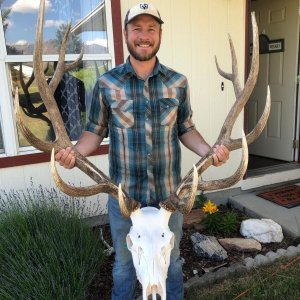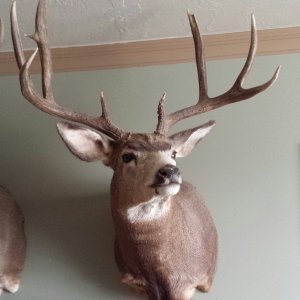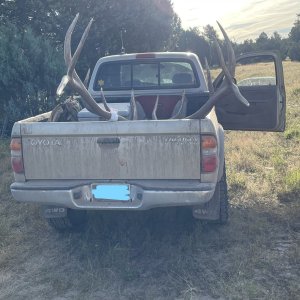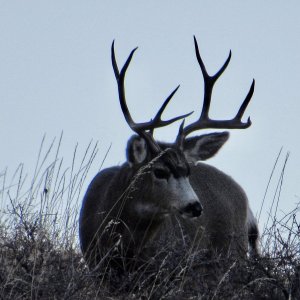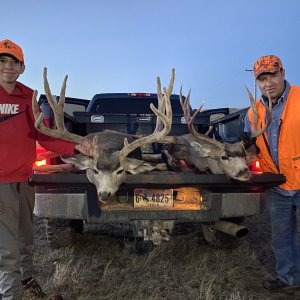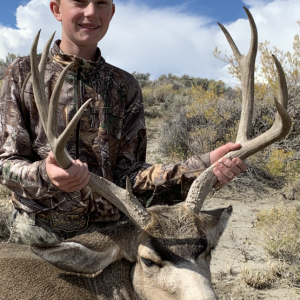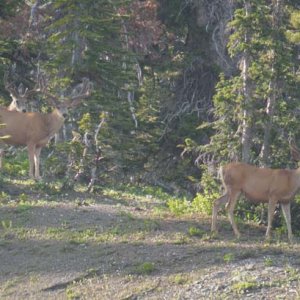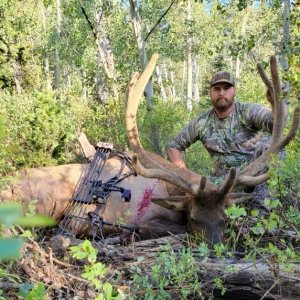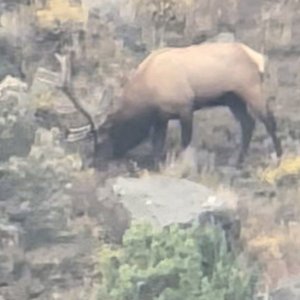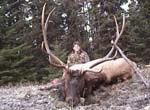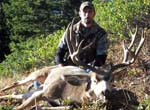B
BowHuntWithaRifle
Guest
Contact your Legislator if you disagree with this new law and make your voice heard. I personally think this is terrible!
IDAHO FISH AND GAME
SOUTHEAST REGION NEWS RELEASE
Pocatello, ID
Date: August 18, 2008
Contact: Jennifer Jackson
(208) 232-4703
regulations for atvs, utvs, motorcycles clarified
The growing popularity of a new generation of four-wheel-drive off-highway vehicle, known as utility type vehicle - or UTV - has raised questions and concerns about off-highway vehicle use on public lands in Idaho.
The Idaho Department of Parks and Recreation and Fish and Game recognize the growing popularity of motorized recreation and desire by motorized vehicle users for appropriate recreational opportunities.
Both agencies want to clarify where and when OHV use is legal and appropriate, and to inform OHV users of a new state law which has prompted some upcoming changes in OHV management.
A variety of opportunities are available on public land for OHV use, including the larger UTVs. OHV owners should consult the appropriate land management agency for travel restrictions in the area they plan to ride. Each agency has its own guidelines or regulations for travel.
Some trails on the Caribou-Targhee National Forest are open to two wheeled motorized travel, and some limit vehicles to a maximum width of 50 inches. All vehicles wider than 50 inches are limited to roads open to motorized travel and subject to licensing requirements.
In the past, many UTV owners thought they could register their vehicle with an OHV sticker and legally operate on the road. It was confusing for just about everybody, but a new law passed during the 2008 legislative session will remedy this situation.
Beginning January 1, 2009, a restricted use license plate will be available to all OHVs, including UTVs. This new plate, in combination with the OHV registration sticker, will allow all OHVs to operate on Forest Service roads unless the land manager specifically prohibits such use.
On Bureau of Land Management lands some motorized routes and areas, such as the St. Anthony sand dunes, are open to UTVs with a current OHV registration sticker. Other motorized routes are limited to 48 inches in width. Roads on BLM lands are similar to Forest Service roads and require a license plate.
After January 1, 2009, the new restricted-use license plate will allow use on roads unless specifically prohibited.
It is the operator's responsibility to know before they go. On federal land it is important for all OHV users to check with their local land managers to identify the legal areas of operation. In most areas maps are available to assist in the identification of legal routes.
The new restricted-use license plate will also allow OHVs legal access to city and county roads. These local jurisdictions may prohibit certain roads from OHV use after a public meeting and an ordinance passed. The new law does not allow OHVs to operate on any state or federal highways.
In addition to vehicle type trail designations, some roads and trails may also be limited by seasonal restrictions. For example, some land managers may close roads or trails to any motorized travel during various times of the year to control big game vulnerability during the hunting season, to benefit wintering wildlife or to protect the trail surface during wet conditions. Most seasonal closures can be identified on the land managers travel map.
Idaho Fish and Game generally limits the use of OHVs on its wildlife management areas to established open roads - exceptions are Andrus and Craig Mountain WMAs - and also restrict the use of OHVs as an aid to hunting in certain game management units.
Parks and Recreation and Fish and Game suggest OHV recreationists not keep their OHVs parked in their driveways, but make sure they know the rules for enjoying them legally. Check with the appropriate land management agencies; acquire travel maps geared for off-road recreation, and pay attention to signage on public lands. Or contact the nearest Idaho Parks and Recreation office for information on OHV recreation in Idaho.
Permission is always necessary from a land owner for travel on private property.
Frequently Asked Questions about Idaho's New OHV Law
Q. I am an Idaho resident and heard that license plates are going to be required on my off-highway motorcycle, ATV or UTV. Is this true?
A. Yes. Beginning on January 1, 2009, owners of off-highway motorcycles, ATVs and UTVs will be required to buy a restricted use plate for $3 if they will be operating those machines on public land or on public roads. They are not allowed on state and federal highways or federal interstates. The plate is valid for seven years. Exemptions exist for motorcycles with a displacement of 50 cubic centimeters or less and vehicles used exclusively for agricultural or snow removal purposes.
--------------------------------------------------------------------------------
Q. How big is the restricted use plate?
A. The plate will be the same size and material as the current plate used on motorcycles. The plate will be white with black lettering and must be displayed on the rear of the vehicle.
--------------------------------------------------------------------------------
Q. What happened to the $10 OHV sticker?
A. The OHV sticker will now be smaller and must be affixed to the restricted use plate on the rear of the vehicle. The sticker will be valid for one year.
--------------------------------------------------------------------------------
Q. Do I need both a "restricted use" plate and an off-highway vehicle sticker?
A. Yes. Exemptions include motorcycles with a displacement of 50cc or less and vehicles used exclusively for agricultural or snow removal purposes.
--------------------------------------------------------------------------------
Q. Where can I ride with my restricted use plate and OHV sticker?
A. All state or federal roads, excluding state and federal highways and interstates, will be open to off-highway motorcycles, ATVs and UTVs with a restricted use plate and current year OHV sticker unless a local ordinance is adopted to close a road to such use or otherwise determined closed by a federal land manager. Designated OHV riding areas, areas open to cross-country motorized travel and designated motorized trail systems on public land will require both the restricted use plate and the OHV sticker.
--------------------------------------------------------------------------------
Q. I converted my off-highway motorcycle to a regular motorcycle and already have a red, white and blue motorcycle plate on it from ITD. Does this mean I now need two plates on my bike?
A. No. Only one plate is necessary. To ride on trails, you will still need the $10 OHV sticker and must affix it to your existing motorcycle license plate. This is in addition to the current motorcycle license plate registration sticker provided by Idaho Transportation Department with the motorcycle plate.
--------------------------------------------------------------------------------
Q. How does this new law affect non-residents?
A. Nothing was changed to the non-resident registration requirements. Non-residents are not required to register in Idaho unless they have operated within the state for more than 30 days.
--------------------------------------------------------------------------------
Q. Does this law allow children to ride on roads?
A. No. When traveling on roads, operators of an off-highway motorcycle, ATV or UTV must have a valid driver's license, carry liability insurance and have a vehicle equipped with the required equipment to do so.
--------------------------------------------------------------------------------
Q. What required equipment must I have on my off-highway motorcycle, ATV or UTV to travel on a road?
A. The required equipment is still being determined. Current code requires a number of items including a mirror, a working brake light, and a horn audible at 200 feet.
--------------------------------------------------------------------------------
Q. Where do I get plates and stickers in 2009?
A. On January 1, 2009, you must buy the restricted use plate and OHV sticker from the Idaho Transportation Department. Specifically your county assessor's automobile licensing office.
--------------------------------------------------------------------------------
Q. What do I need to take with me to obtain both plates and stickers?
A. You will need to have your vehicle identification number with you if it is currently titled in Idaho. If your vehicle isn't titled in Idaho, you will need to contact your county assessor's automobile licensing office and begin the titling process with ITD.
--------------------------------------------------------------------------------
Q. Where do I go to renew my OHV sticker in 2010?
A. All Idaho Parks and Recreation registration vendors, including county assessor automobile licensing offices, OHV dealers and other businesses that sell OHV registration stickers, will be able to issue the OHV renewal stickers.
--------------------------------------------------------------------------------
For additional information please call your county assessor's automobile licensing office or the Idaho Department of Parks and Recreation in Boise at 208-334-4199, in Coeur d'Alene at 208-769-1511, and in Idaho Falls at 208-525-7121.
For additional information contact Troy Elmore of the Idaho Department of Parks and Recreation at 208-514-2411 or Mark Gamblin of Idaho Fish and Game at 208-232-4703.
"I shoot at wolves, I don't dance with them."
Stands With A Fist
IDAHO FISH AND GAME
SOUTHEAST REGION NEWS RELEASE
Pocatello, ID
Date: August 18, 2008
Contact: Jennifer Jackson
(208) 232-4703
regulations for atvs, utvs, motorcycles clarified
The growing popularity of a new generation of four-wheel-drive off-highway vehicle, known as utility type vehicle - or UTV - has raised questions and concerns about off-highway vehicle use on public lands in Idaho.
The Idaho Department of Parks and Recreation and Fish and Game recognize the growing popularity of motorized recreation and desire by motorized vehicle users for appropriate recreational opportunities.
Both agencies want to clarify where and when OHV use is legal and appropriate, and to inform OHV users of a new state law which has prompted some upcoming changes in OHV management.
A variety of opportunities are available on public land for OHV use, including the larger UTVs. OHV owners should consult the appropriate land management agency for travel restrictions in the area they plan to ride. Each agency has its own guidelines or regulations for travel.
Some trails on the Caribou-Targhee National Forest are open to two wheeled motorized travel, and some limit vehicles to a maximum width of 50 inches. All vehicles wider than 50 inches are limited to roads open to motorized travel and subject to licensing requirements.
In the past, many UTV owners thought they could register their vehicle with an OHV sticker and legally operate on the road. It was confusing for just about everybody, but a new law passed during the 2008 legislative session will remedy this situation.
Beginning January 1, 2009, a restricted use license plate will be available to all OHVs, including UTVs. This new plate, in combination with the OHV registration sticker, will allow all OHVs to operate on Forest Service roads unless the land manager specifically prohibits such use.
On Bureau of Land Management lands some motorized routes and areas, such as the St. Anthony sand dunes, are open to UTVs with a current OHV registration sticker. Other motorized routes are limited to 48 inches in width. Roads on BLM lands are similar to Forest Service roads and require a license plate.
After January 1, 2009, the new restricted-use license plate will allow use on roads unless specifically prohibited.
It is the operator's responsibility to know before they go. On federal land it is important for all OHV users to check with their local land managers to identify the legal areas of operation. In most areas maps are available to assist in the identification of legal routes.
The new restricted-use license plate will also allow OHVs legal access to city and county roads. These local jurisdictions may prohibit certain roads from OHV use after a public meeting and an ordinance passed. The new law does not allow OHVs to operate on any state or federal highways.
In addition to vehicle type trail designations, some roads and trails may also be limited by seasonal restrictions. For example, some land managers may close roads or trails to any motorized travel during various times of the year to control big game vulnerability during the hunting season, to benefit wintering wildlife or to protect the trail surface during wet conditions. Most seasonal closures can be identified on the land managers travel map.
Idaho Fish and Game generally limits the use of OHVs on its wildlife management areas to established open roads - exceptions are Andrus and Craig Mountain WMAs - and also restrict the use of OHVs as an aid to hunting in certain game management units.
Parks and Recreation and Fish and Game suggest OHV recreationists not keep their OHVs parked in their driveways, but make sure they know the rules for enjoying them legally. Check with the appropriate land management agencies; acquire travel maps geared for off-road recreation, and pay attention to signage on public lands. Or contact the nearest Idaho Parks and Recreation office for information on OHV recreation in Idaho.
Permission is always necessary from a land owner for travel on private property.
Frequently Asked Questions about Idaho's New OHV Law
Q. I am an Idaho resident and heard that license plates are going to be required on my off-highway motorcycle, ATV or UTV. Is this true?
A. Yes. Beginning on January 1, 2009, owners of off-highway motorcycles, ATVs and UTVs will be required to buy a restricted use plate for $3 if they will be operating those machines on public land or on public roads. They are not allowed on state and federal highways or federal interstates. The plate is valid for seven years. Exemptions exist for motorcycles with a displacement of 50 cubic centimeters or less and vehicles used exclusively for agricultural or snow removal purposes.
--------------------------------------------------------------------------------
Q. How big is the restricted use plate?
A. The plate will be the same size and material as the current plate used on motorcycles. The plate will be white with black lettering and must be displayed on the rear of the vehicle.
--------------------------------------------------------------------------------
Q. What happened to the $10 OHV sticker?
A. The OHV sticker will now be smaller and must be affixed to the restricted use plate on the rear of the vehicle. The sticker will be valid for one year.
--------------------------------------------------------------------------------
Q. Do I need both a "restricted use" plate and an off-highway vehicle sticker?
A. Yes. Exemptions include motorcycles with a displacement of 50cc or less and vehicles used exclusively for agricultural or snow removal purposes.
--------------------------------------------------------------------------------
Q. Where can I ride with my restricted use plate and OHV sticker?
A. All state or federal roads, excluding state and federal highways and interstates, will be open to off-highway motorcycles, ATVs and UTVs with a restricted use plate and current year OHV sticker unless a local ordinance is adopted to close a road to such use or otherwise determined closed by a federal land manager. Designated OHV riding areas, areas open to cross-country motorized travel and designated motorized trail systems on public land will require both the restricted use plate and the OHV sticker.
--------------------------------------------------------------------------------
Q. I converted my off-highway motorcycle to a regular motorcycle and already have a red, white and blue motorcycle plate on it from ITD. Does this mean I now need two plates on my bike?
A. No. Only one plate is necessary. To ride on trails, you will still need the $10 OHV sticker and must affix it to your existing motorcycle license plate. This is in addition to the current motorcycle license plate registration sticker provided by Idaho Transportation Department with the motorcycle plate.
--------------------------------------------------------------------------------
Q. How does this new law affect non-residents?
A. Nothing was changed to the non-resident registration requirements. Non-residents are not required to register in Idaho unless they have operated within the state for more than 30 days.
--------------------------------------------------------------------------------
Q. Does this law allow children to ride on roads?
A. No. When traveling on roads, operators of an off-highway motorcycle, ATV or UTV must have a valid driver's license, carry liability insurance and have a vehicle equipped with the required equipment to do so.
--------------------------------------------------------------------------------
Q. What required equipment must I have on my off-highway motorcycle, ATV or UTV to travel on a road?
A. The required equipment is still being determined. Current code requires a number of items including a mirror, a working brake light, and a horn audible at 200 feet.
--------------------------------------------------------------------------------
Q. Where do I get plates and stickers in 2009?
A. On January 1, 2009, you must buy the restricted use plate and OHV sticker from the Idaho Transportation Department. Specifically your county assessor's automobile licensing office.
--------------------------------------------------------------------------------
Q. What do I need to take with me to obtain both plates and stickers?
A. You will need to have your vehicle identification number with you if it is currently titled in Idaho. If your vehicle isn't titled in Idaho, you will need to contact your county assessor's automobile licensing office and begin the titling process with ITD.
--------------------------------------------------------------------------------
Q. Where do I go to renew my OHV sticker in 2010?
A. All Idaho Parks and Recreation registration vendors, including county assessor automobile licensing offices, OHV dealers and other businesses that sell OHV registration stickers, will be able to issue the OHV renewal stickers.
--------------------------------------------------------------------------------
For additional information please call your county assessor's automobile licensing office or the Idaho Department of Parks and Recreation in Boise at 208-334-4199, in Coeur d'Alene at 208-769-1511, and in Idaho Falls at 208-525-7121.
For additional information contact Troy Elmore of the Idaho Department of Parks and Recreation at 208-514-2411 or Mark Gamblin of Idaho Fish and Game at 208-232-4703.
"I shoot at wolves, I don't dance with them."
Stands With A Fist

